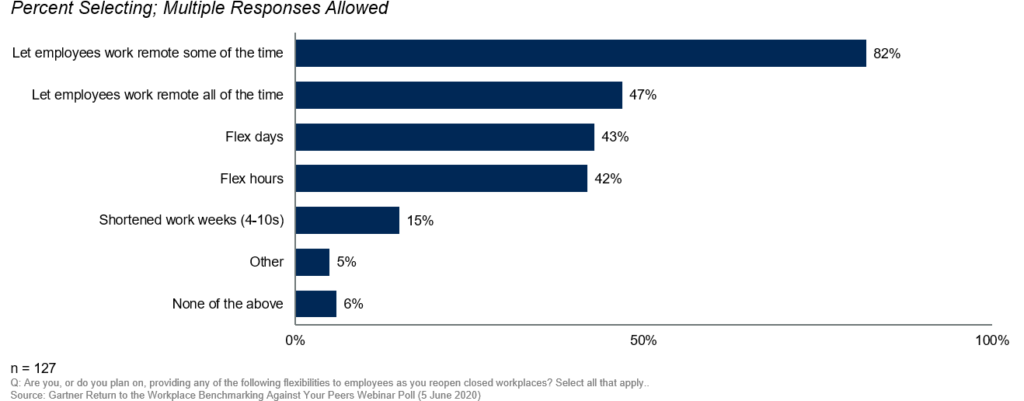In this guide to hybrid working, we explore the factors making hybrid or flexible work the future of the workplace.
Apart from being the biggest public health crisis in modern history, COVID-19 was also the great accelerator of remote work. What’s more, this historic shift to new ways of working is likely to be permanent.
Gartner research shows that of the 127 company leaders surveyed in June 2020, 47% said they intend to allow employees to work remotely full-time in the near future, and 82% said they’d permit it on a part-time basis.

Image Source: Gartner
Meanwhile, a study by LifeSearch and the Centre for Economics and Business Research (CEBR) found that nearly half (44%) of British employees prefer some form of hybrid working to be the norm in the workplace — this proportion rises to 65% of employees between the ages of 18 to 24.
Related Reading: Leading Remote Teams in 2022: Top Challenges, Tips and Tools
In other words, the pandemic may have shown that employees can work from home and be productive, but a significant number of workers still recognise the value of the office.
The win-win solution for everyone is hybrid work.
WHAT DOES HYBRID WORKING MEAN?
At its simplest, hybrid working is a form of flexible working combining remote work with co-located work set-ups. With hybrid work, employees come to the office on certain days and work from home (or any other location they prefer) on others.
This arrangement gives managers and employees the best of both worlds.
On one hand, managers concerned about poor collaboration and teamwork can have days where everyone in the team (or at least some) are in the office. It also helps employees who want separation between their work and home life.
On the other hand, hybrid work affords employees the autonomy and flexibility they get from remote work — albeit on select days of the week.
Sounds simple, right? Not quite.
WHAT ARE THE CHALLENGES OF HYBRID WORK?
As with any structural change to the workplace, shifting to hybrid or partial remote work will require an adjustment period. Employers should also have the necessary IT infrastructure in place to support hybrid teams, both in terms of security and productivity. This will help prevent mistakes companies made at the height of the pandemic, where a third of companies were ill-equipped to make the sudden shift to remote work.
And with the threat of the pandemic still looming large, companies should consider the risks of returning to the office without considering health and safety protocols. If you’re planning to make hybrid work permanent for your workforce, here are some challenges to consider preparing for.
1. MAINTAINING SEAMLESS CONNECTIVITY
Having employees shuttling back and forth between working from home and the office can lead to silos, disparities in communication and loss of knowledge. Organisations need to have the tools and systems ready to ensure seamless connectivity between those in the office and those working remotely.
Related Reading: Managing Remote Teams: 4 Best Practices Used By Successful Remote Teams
How to overcome this hybrid work challenge: We recommend investing in a tech stack that supports agile project management, real-time communication and full visibility of tasks and projects. For example, we recommend that small businesses already using Office tools like Word and Excel adopt the Microsoft 365 suite of workplace productivity tools, including web and mobile app versions of Word, Excel and Powerpoint, as well as Microsoft Teams, OneDrive and SharePoint.
When it comes to your office spaces, you can ensure all meeting rooms have the tech ready to connect with your organisation’s video conferencing software, whether it’s Microsoft Teams or Zoom.
2. MANAGING A SAFE RETURN TO THE WORKPLACE AMID COVID-19
While the Government has relaxed many of the pandemic restrictions in England (at the time of writing), the health risks posed by COVID-19 to office workers are still present.
Under the current Plan A measures:
- Workers are no longer required to work from home, but employers are encouraged to work with employees to agree on a safe return to the workplace.
- Face coverings are no longer required, but people are encouraged to wear a mask in crowded and enclosed spaces.
- Venues and events are no longer required by law to check peoples’ NHS COVID Pass. This can still be done voluntarily, however.
In other words, employers are free to self-regulate and take action as they see fit.
How to overcome this hybrid work challenge: Software and technology offer a number of solutions to support a safe return to work. For example, Rakuten is working with Cisco to install the tech giant’s Meraki MVC smart cameras in its Japan headquarters.
The cloud-enabled smart cameras are designed to interface with switches, sensors and other Internet-of-Things devices, helping Rakuten manage space usage, avoid crowding and automate office facilities such as thermostat control.
3. CYBER SECURITY
The same cyber security challenges hounding remote teams also put hybrid teams at risk.
In a study by cyber exposure company Tenable, 74% of business leaders attribute their recent wave of cyber attacks to weaknesses in technology implemented during the pandemic. Moreover, 80% said their organisations were more exposed to cyber threats due to the advent of remote work.
Related Reading: The Importance Of Cyber Security And The Cloud For Remote Teams
How to overcome this hybrid work challenge: Consider investing in cyber security services and accelerating your cloud maturity. While no computing environment is bulletproof, cloud computing environments are widely trusted, with 85% of global IT leaders believing the cloud to be just as and more secure than on-premise IT infrastructure.

Image Source: Google Cloud
Cloud-based systems, such as SaaS software and cloud storage benefit from built-in encryption. This creates another layer of security, making it more difficult for attackers to use your data, even if they somehow get their hands on it — as any human-readable information will be incomprehensible.
Keeping your data and workloads in the cloud ensures that whether your employees work from home or the office, they’ll always have secure access to their applications and tools.
PREPARE FOR THE FUTURE OF HYBRID WORK
Hybrid working is by no means a new concept, but it’s quickly shaping up to be the new normal of work. While the pandemic has proven that remote work advocates were right all along, the office still has value. There is something to be said about face-to-face interactions and working in the same physical space.
What we know for sure is that organisations can benefit from trying new ways of working, whether it’s from shared public spaces or in the comfort of people’s homes. Whatever the case, businesses need the right tech infrastructure and support to make this new hybrid environment work.
At Optimising IT, our IT consultancy services include bespoke solutions and recommendations for remote and hybrid teams. We can work with your team to provide cyber security training, cloud services and Microsoft 365 licensing and support. Contact our team to schedule a FREE IT review of your tech stack today.












